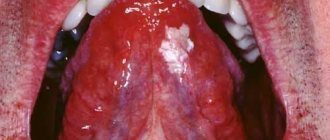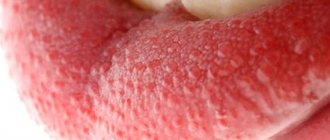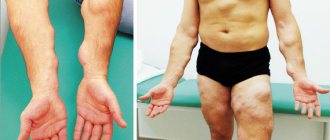Causes of growths under the tongue
Formations on the tissues of the tongue and oral mucosa appear when the growth mechanism of epithelial cells fails. This process is provoked mainly by condylomatosis or the so-called papilloma virus. The disease is considered insidious due to hidden symptoms at an early stage of development, which complicates early diagnosis. In addition, it is contagious, the virus is transmitted even through kisses and shared household items, not to mention closer contacts of partners (sex of different types).
Children can become infected with condylomatosis at birth from an infected mother, therefore, when the disease is detected in a pregnant woman, it is recommended to allow labor by cesarean section.
Methods for diagnosing tongue cancer
Examination of the tongue and oral cavity
Diagnosis of tongue cancer involves a comprehensive examination, which includes the following manipulations:
- Examination of the oral cavity.
- Palpation of the tumor and areas of regional lymph nodes.
- Verification of diagnosis using cytological examination. To do this, a puncture biopsy and/or impression smears from the tumor are taken.
- MRI - evaluates the soft tissues of the head and neck, as well as the degree of tumor invasion in them.
- CT with contrast - helps to evaluate the presence of cancer growth in the bones, in particular in the lower jaw.
- Ultrasound examination of the area of regional metastasis can identify metastases.
According to indications, endoscopic examination of the pharynx, chest x-ray and other diagnostic methods can be performed, which are aimed at clarifying the extent of the malignant process and detecting distant metastases. [3.6]
Symptoms
You can recognize a problem in the oral cavity by the following signs:
- seals, tubercles, small antennae or outgrowths form under the tongue, which are clearly visible upon visual inspection;
- the shape of the formation is filamentous or elliptical;
- the texture is soft and smooth, no peeling is observed;
- the color of the growth may be the same as the mucous membrane, or have a reddish, whitish tint;
- the formation is 2-20 mm in diameter.
External manifestations (+photo)
Growths under the tongue in humans form in the form of warts, papillomas, and condylomas. All varieties are signs of the presence of VPI in the body. Their differences lie in the type of epithelium and external manifestation. Papillomas can be either protruding above the surface of the mucous membrane or flat with rough tissue. And condylomas always rise above the surface of the skin or mucous membrane with the help of a fairly high stalk.
Types of growths under the tongue:
Depending on the type and causes of formation, condylomas come in different colors:
- red;
- white;
- light with a yellow tint;
- pink;
- gray;
- from light to dark brown.
Growths in the oral cavity are most often localized in the following areas:
- on the mucous membrane under the tongue;
- on the bridle;
- on the gum under the tongue;
- on the inside of the tongue;
- along the rim of the tongue and other areas of the mucous membrane.
Which people are susceptible to papillomas?
Based on the information we provided above, we can distinguish several “risk groups”, people in which are susceptible to the development of growths and neoplasms on the tongue and body.
The appearance of a process on the tongue is possible:
- In a situation where a person has reduced immunity as a result of stress, the presence of parasites in the body or ongoing inflammatory processes.
- If a patient with a growth in the mouth suffers from autoimmune diseases.
- In a person with HIV infection.
- In people who are promiscuous.
- In the event that a person has bad habits. Smoking and drinking alcohol especially contribute to the appearance of neoplasms in the form of growths on the tongue.
- If there was any trauma to the tongue or damage to the mucous membrane occurs systematically.
Diagnostics
Examination by an otolaryngologist
If characteristic growths are detected in the oral cavity, you should contact one of the recommended specialists (depending on the location of the focal zone):
- dentist;
- otolaryngologist;
- dermatovenerologist.
It would also be a good idea to visit an oncologist to rule out the possibility of developing a tumor of malignant origin.
Diagnosis of condylomatosis and other diseases associated with the formation of growths under the tongue consists of the following steps:
- visual examination by a doctor;
- taking anamnesis;
- laboratory research;
- histology.
How to spot early symptoms of tongue cancer
20.06.18
The fear of getting cancer is quite common and is called cancerophobia, or less commonly, cancrophobia. I would say, given the inclusion of cancer in the top five most common causes of death, that this fear is quite constructive if it prompts you to avoid risk factors and be regularly examined by an oncologist. This is good form - modern and responsible.
Tongue cancer is less common than many other types of cancer, but the fear of it is great due to the expected disability and significant impairment of quality of life.
What needs to be done to catch it at an early stage, at which it is possible to do without crippling methods of treatment?
Tongue cancer is insidious - its early manifestations are masked by harmless symptoms and require an active search even with regular examination. The greatest likelihood of detecting the first symptoms occurs during a regular dentist appointment. Firstly, he knows well what a healthy tongue should look like, and secondly, he knows what to do if he suspects the onset of a disease. It is important to understand that the dentist will notice early symptoms if you ask about it at the appointment, present complaints or concerns. If dangerous symptoms are detected, the dentist is obliged to refer the patient to an oncologist.
Particular attention to the tongue and oral cavity should be given to smokers, people working with carcinogens - asbestos, perchlorethylene, petroleum products and heavy metal salts. The second place among the risk factors for developing tongue cancer is microtrauma from sharp edges of teeth, poorly fitting dentures and fillings. The so-called precancerous diseases and conditions are important - erosion of the tongue, leukoplakia, papillomas, hyperkeratic and ulcerative-erosive forms of systemic lupus erythematosus and lichen planus, Bowen's disease.
Men suffer from tongue cancer 6-7 times more often than women. The reasons for this are poorly understood, it is assumed that they are more likely to be exposed to harmful factors, but it is possible that cancer is inherited on the Y chromosome.
Most often the lateral surface of the tongue is affected, less often the root or bottom of the tongue, and least often the surface. The tip of the tongue accounts for only 3% of identified cases. To identify tongue cancer at an early stage, let’s remember its three main manifestations:
- the presence of papillary growths or whitish spots, compactions or redness on the tongue, special attention to the lateral surfaces!
- enlargement of the submandibular lymph nodes
- soreness in the tongue without clear localization. This symptom is rare, more often it is simply a feeling of discomfort, an unusual sensation in the tongue.
At this stage, the oncologist will do a smear test or biopsy to identify the type of cancer or rule it out. By the way, for the initiated, in 95% of histologically, tongue cancer is classified as squamous, i.e. develops rapidly and metastasizes quickly.
At the second stage, it is called “developed”, the symptoms are more distinct, but the treatment prognosis is worse.
- the pain becomes more localized, radiating to the ear, temple or oral organs
- salivation increases
- there will be a bad breath
- There is numbness in parts of the tongue, difficulty pronouncing sounds, pain when swallowing
- with the papillary form, a distinct growth will appear on the tongue (see illustration), with the ulcerative form, a growing ulcer with a distinct ridge along the edges (also shown in the illustration)
- in the infiltrative-ulcerative form, deep fissure ulcers appear on the tongue; in the infiltrative form, the body of the tongue thickens
The advanced stage is quite obvious and we will not consider it within the scope of this material.
Treatment for tongue cancer is always complex, including surgery, radiation therapy and chemotherapy. Prevention consists of quitting smoking, limiting alcoholic beverages, and regular dental and oral care.
Timely diagnosis allows for a favorable survival prognosis, which some authors note at 95%. But here, the sooner the patient applies, the better the prognosis. Attention to health, accuracy and systematic reasonable self-observation can give many years of active life.
Types of processes
Most often, flat or pointed warts form in the oral cavity:
- Flat formations have a small protrusion above the mucous membrane and tissues, their shape is predominantly round. Condyloma differs in color from the general background in a brighter shade, so identifying it is quite simple. It is quite dense to the touch and is localized on the lower part of the tongue and oral mucosa.
Flat build-up
- Pointed papillomas form individually in the form of nodules or as a whole family, which makes them similar to cauliflower. They are moderately soft and elastic to the touch.
Pointed growth
Another type of growth is condylomas lata, which are localized not only on the tongue, but also on other parts of the oral mucosa. The reason for their appearance is syphilis.
What does papilloma look like on the frenulum of the tongue?
Photo of papillomas on the frenulum of the tongue
The frenulum of the tongue is located in the middle of the organ and continues it, only in case of anomalies it is located closer to its end, and in this case the diagnosis of “ankyglossia” is made. Here, papilloma can appear both above and directly below it. In such a situation, a person usually experiences some discomfort, which intensifies while eating.
The following types of papillomas can grow on the frenulum of the tongue:
- Filiform . They do not come into close contact with the skin, connecting to it only through a thin stalk. Because of this, as a result of mechanical or chemical action, such growths often come off, which entails discomfort and bleeding. The size of this type of papillomas ranges from 0.3 mm to 1 cm.
- Genital warts . They can mainly be seen on the genitals, but there is a possibility of such papillomas appearing in the oral cavity on the frenulum of the tongue. These formations are very easy to recognize due to their pronounced, uneven surface covered with numerous nodules. On average, their size is 1-2 cm, which makes this type of growth the largest. Their color is usually deep red, and the boundaries are not clear.
- Flat . Such neoplasms appear mainly in several pieces and can remain unnoticed for a long time. Their surface is smooth, the color is pinkish-yellow, and the shape is regular and round. With small sizes, up to 5 mm, there is no discomfort.
- Vulgar . Such papillomas on the frenulum of the tongue (photos can be viewed online) look like knobby growths. They have a flat base and practically do not rise above the skin. They are often mistaken for warts due to their relatively even shape and smooth surface. Their color is pink or beige.
Papillomas on the frenulum of the tongue are most often benign, but the risk of their degeneration into malignant is still present. Their symptoms include a sensation of a foreign body in the mouth, a slight burning sensation, slight bleeding, an unpleasant odor, redness and swelling of the mucous membranes.
Before treating papilloma on the frenulum of the tongue, a diagnosis is always carried out, for which the doctor collects an anamnesis, evaluates the patient’s complaints, and issues referrals for the necessary studies. Most often, histological and PCR analysis is required. The first allows you to exclude cancer cells in the structure of the growth, and the second helps to determine the degree of oncogenicity of the virus that caused the formation.
Drug treatment
A mandatory part of treatment is sanitation of the oral cavity.
To eliminate growths under the tongue with condylomatosis, complex treatment is used, which includes:
- taking antiviral drugs;
- the use of antiseptic solutions and ointments for local treatment of the affected area;
- carrying out complete sanitation of the oral cavity at the dentist (treatment of caries, inflammation of dentin, and other problems);
- consumption of a vitamin complex to strengthen the body’s protective functions;
- taking immunomodulatory drugs;
- removal of growths using surgery, a laser beam or radio waves.
During the period of therapy, it is important to reconsider your usual lifestyle and make adjustments to it, getting rid of bad habits and casual relationships. To speed up the healing process, you need to avoid irritating the mucous membranes with hot or too cold drinks and dishes. Hygiene procedures should be carried out regularly, at least 2 times a day, using high-quality cleaning products.
Popular antiviral drugs include:
- Acyclovir (tablets);
- Panavir (solution for intravenous injection);
- Isoprinosine (tablets);
- Allokin-Alpha;
- Alpizarin (tablets).
The following are considered effective immunomodulators: Derinat, Likopid, Immunomax, Polyoxidonium.
For local impact on the lesion, the following means are used:
- Podophyllin;
- Cryopharma;
- Lapis pencil;
- Solcoderm;
- Verrukacid et al.
When using local preparations, you need to carefully read the instructions so that during the treatment of papillomas you do not burn healthy mucosal tissue.
Treatment methods for papillomas under the tongue
If growths occur on the skin, then the diagnosis is usually carried out by a dermatologist, if they are localized in the vagina - by a gynecologist, in the anus - by a proctologist. If neoplasms begin to appear in the oral cavity, you should contact an otolaryngologist or dentist. It is these specialists who will carry out the initial examination and prescribe the necessary diagnostic procedures, and then complex therapy. Sometimes it is not superfluous to consult an oncologist. Let’s look in more detail at what kind of treatment for papilloma under the tongue the attending physician can prescribe.
Treatment of papillomas in the mouth with medications
In the photo there are medications for papillomas in the mouth
At the moment, there is no single treatment regimen for HPV, which is why each doctor is guided by general recommendations and his own experience when choosing certain treatment measures.
Sometimes, as a first measure, instrumental removal of papillomas under the tongue is prescribed, and then the necessary medications are prescribed to reduce the activity of the virus and prevent the reappearance of tumors in the oral cavity. In other cases, the primary goal is to reduce the viral load with medication, suppress the growth of growths with possible destruction, and after 2-3 weeks, removal if necessary. In any case, both methods - medicinal and instrumental - go hand in hand with each other.
The list of drugs prescribed for the treatment of HPV and the fight against benign papillomas under the tongue includes antiviral, immunostimulating, and fortifying drugs, namely:
- Arbidol . Included in the group of antiviral drugs. It is considered capable of suppressing the ability of HPV to reproduce. Strengthens immunity. It has a small list of contraindications, applicable from 2 years of age. The price in Russian pharmacies is from 150 rubles, in Ukrainian - from 85 hryvnia.
- Allokin-alpha . Activates the functionality of killer cells, which helps reduce the viral load and partial or complete destruction of papilloma in the mouth under the tongue. Triggers the process of synthesis of natural interferon in the carrier’s body. It is safe to use, but is not recommended for use in patients under 12 years of age. Price - 3700 rubles or 1900 hryvnia.
- Vitrum . Vitamin and mineral complex. Eliminates the lack of nutrients. Increases resistance to various infections. Normalizes metabolism. Price - 400 rubles or 190 hryvnia.
- Viferon . Contains interferon in different dosages. Reduces the ability of the virus to reproduce. Suppresses the growth of tumors in the oral cavity and other parts of the body by enhancing the cytotoxic activity of lymphocytes. Provides an anti-inflammatory effect, helps accelerate the regeneration of healthy cells and the healing of postoperative scars. It has virtually no contraindications and is prescribed from the first days of life. Release form: ointment, suppositories. Cost - from 290 rubles or 160 hryvnia.
- Genferon . In addition to interferon, the drug formula contains taurine and anesthesin, thanks to which the drug has a complex effect. Stimulates the synthesis of immunoglobulin A, fights the virus, restores the ability of cells to regenerate, which contributes to the rapid destruction of papillomas under the tongue and the restoration of healthy tissue. The drug also relieves pain. Release form: candles. Price - 600 rubles or 320 hryvnia.
- Duovit . Vitamin complex replenishes the deficiency of nutrients. Stimulates an increase in the body's defenses. Price - from 200 rubles (from 130 hryvnia).
- Isoprinosine . Participates in stimulating the natural production of antibodies. Blocks the ability of viral DNA to integrate into healthy cells. Stimulates the destruction of papillomas under the tongue. To achieve greater treatment effectiveness, it should be used in combination with other antiviral medications. Price - 650 rubles or 320 hryvnia.
- Immunomax . Increases the body's natural resistance to pathogenic microbes. Blocks the growth of tumors. Applicable from 12 years of age. The price in Russia is from 1000 rubles, and in Ukraine – from 600 hryvnia.
- Lycopid . Participates in stimulating the production of interleukins, provokes the destruction of epithelial growths in the oral cavity and on the human body. The price in Russia is 320 rubles, in Ukraine - 190 hryvnia.
- Lymphomyazot . Designed to strengthen the immune system. There are practically no restrictions in use. It does not directly affect papillomas under the tongue and in other places. Cost - 600 rubles (330 hryvnia).
- Multi-tabs . The composition contains a complex of vitamins and minerals. The dosage is developed taking into account the daily need for a particular useful substance. Restores the balance of beneficial compounds, which improves health and immunity. The price in Russia is 380 rubles, in Ukraine – 200 hryvnia.
Cauterizing agents for external use - Ferezol, Solcoderm, Oxolinic ointment, Malavit, etc. - are most often not prescribed for the treatment of papilloma under the tongue, because There is a high risk of chemical burns.
To reduce the risk of infection and relieve inflammation, you should carefully monitor the health of your teeth and gums and sanitize your oral cavity. For this you can use Cholisal. It is an anti-inflammatory, antimicrobial and anesthetic agent. The price in Russian pharmacies is 450 rubles, in Ukrainian - 120 hryvnia.
Folk remedies for treating papilloma under the tongue
A considerable number of people delay going to the doctor as much as possible and try to treat themselves using traditional medicine. When the first signs of the disease appear, many people wonder how to treat papillomas under the tongue at home. There are many options. Let's tell you more about the most popular products.
Folk remedies for the treatment of tumors under the tongue caused by the HPV virus:
- Potato juice . Several root vegetables are grated and the juice is squeezed out of the mass, which is used for rinsing. Localization of papilloma in the mouth under the tongue allows you to retain liquid for a longer time, which will allow the remedy to work more effectively.
- Cranberry juice . Very rich in vitamins and antioxidants. It perfectly stimulates the immune system and helps fight the virus, albeit slightly reducing the risk of new tumors appearing in the oral cavity.
- Dandelion milk . This remedy is available only in warm weather, when you can pick the stem of a fresh plant. A whitish paste appears at the cut site, which should be applied to papillomas on the lips and under the tongue.
- Herbal infusion . It includes oak bark, sage and calendula flowers. The ingredients taken in equal proportions are heated in a water bath, infused, and then used for rinsing. The product perfectly sanitizes the oral cavity and helps get rid of tumors.
- Castor oil . It has a local antiviral effect and stimulates regeneration processes in epithelial cells. Method of application: rub into the affected area under the tongue or apply a mini-compress with a cotton pad.
- Walnut . For the procedure, green nuts are selected, their core is crushed and filled with a small amount of kerosene. Infusion time: 3 weeks. Next, the mass is filtered, and the resulting liquid is used to treat papillomas in the mouth under the tongue.
- Infusion of medicinal herbs . Increases immunity, improves well-being, and replenishes the deficiency of nutrients. The ingredients for the infusion - nettle, lemon balm, plantain, dandelion root and horsetail - are taken in equal proportions, crushed, poured with water and boiled over low heat for only 10-15 minutes. Then infuse for 3 hours and filter. The liquid is consumed daily 3 times in a volume of 40-60 ml.
To increase immune protection, tinctures of ginseng, Manchurian aralia, and lemongrass are useful.
For growths on the skin, iodine, garlic, laundry soap, hydrogen peroxide, and vinegar are often used. They are excellent at burning out formations, however, using these products to treat papillomas under the tongue is not recommended due to the aggressive chemical effects that can easily cause burns.
Practice shows that all folk remedies are characterized by poor effectiveness in the fight against HPV and papillomas. The duration of exposure for complete removal of growths is at least 2 weeks with repeated daily manipulations. It is noteworthy that many people, giving preference to traditional medicine, miss the moment when it was possible to carry out treatment and prevent negative consequences in the form of an increase in lesions and infection of new areas.
Removal methods
There are several ways to remove growths under the tongue. In each individual case, the specialist selects the best option, taking into account the localization of the formation and the extent of the affected area. Whatever method is used, it is complemented by antiviral therapy to prevent relapses. Only an integrated approach, including taking medications, will help get rid of the problem in the oral cavity.
| Treatment of growths under the tongue | |
| Method name | Process description |
| Surgical removal | An effective way to remove growth by cutting it off from soft tissue using surgical instruments: scalpel, scissors, electric knife, conchot. Sutures are subsequently placed on the wound. |
| Cryodestruction | The growths are removed using liquid nitrogen. The method copes with the task, but this type of influence can provoke malignancy of the formation, that is, have the opposite effect. |
| Laser removal | The essence of the method is to cut off the growth with a laser beam. The advantages of the method: quick and effective elimination of formations, absence of pain for the patient and bleeding, which prevents infection. The likelihood of relapse is very low; after the procedure, the process of cell regeneration is stimulated. |
| Radio wave therapy | The method is low-traumatic and painless; the procedure does not even require the use of a local anesthetic. Removal of growths occurs under the influence of high frequency radio waves. The specialist directs them to the base of the growth and cuts off the affected tissue. The rehabilitation period lasts 7-10 days. |
| Electrocoagulation | This method efficiently and quickly removes pedunculated growths on the tongue. The essence of the method is to throw a loop of special fiber over the formation and apply high-frequency current to the material. The hot fiber cuts off the growth, simultaneously soldering the microvessels, which prevents bleeding and infection of the wound. Electrocoagulation prevents further development of the virus. At the site of the removed growth, a crust forms, which after some time comes off on its own. |
| Galvanocaustics | The location of the small growth is cauterized with platinum wire heated under the influence of current. The method is fast, eliminating bleeding and infection of the wound. |
Laser removal
Laser removal of papillomas under the tongue is considered the most effective and safe method of removing formations on the human body. Laser removal is recommended for advanced stages of the virus, when the body is no longer able to get rid of it on its own. The procedure is prescribed by the attending physician and in most cases is painless, without bleeding or pain.
Laser removal is prescribed after long and unsuccessful treatment with medications. Sometimes, after a large papilloma, shallow scars may remain, which over time will become invisible. The number of procedures depends on the stage of the virus; usually a session lasts 4-5 sessions. The rays contribute not only to getting rid of papillomas, but also to the speedy restoration of the oral wall. Laser beams cauterize the papillomas tissue. In rare cases, the procedure is performed under local anesthesia.
The following cannot undergo this procedure:
- pregnant women - rays can negatively affect the health of the fetus;
- patients with chronic diseases;
- patients with severely weakened immune systems – laser therapy can worsen the immune system, making the body vulnerable to the outside world and other diseases.
What to do at home if a growth appears - folk methods
In addition to traditional treatment of growths under the tongue, many patients use traditional recipes. It is impossible to replace treatment with a completely unconventional method, but nothing prevents you from trying it.
Popular folk recipes for growths under the tongue:
- daily rubbing of the formations with garlic juice or applying cloves of spice;
- lubricating newly appeared growths with egg white;
- treating affected areas with castor oil (using cotton swabs);
- rinse the mouth twice a day with decoctions of medicinal herbs (medicinal chamomile, string, sage, echinacea, etc.);
- ingesting rosehip decoction, freshly squeezed potato or carrot juice.
Any infections and viruses developing in the body signal a decrease in immunity, so during the treatment period you should take care of taking fresh vegetables and fruits. A good vitamin complex is also suitable for these purposes.
Before using an unconventional approach, you should consult your doctor to rule out contraindications.
Causes
Among the main causes of papilloma under the tongue, the photo of which is below, in humans, doctors identify the following:
- Violation of personal hygiene rules.
- The use of other people's personal hygiene products is one of the factors in the occurrence of papillomas in humans.
- Injuries to the oral cavity.
- Persistent decrease in the body's immune forces.
- Occurs due to age-related changes.
- Lack of vitamin and mineral components.
- Harmful habits.
- Develops in people with immunodeficiency.
- In women during hormonal changes.
- During the period of active hormone activity, the risk of developing formations increases, especially during gestation and lactation.
- The possibility of developing the virus during menopause and menopause also increases significantly.
- Oral route of transmission. Oral sex is one of the most dangerous ways of contracting the human papillomavirus. Since the pathogen penetrates into the deep layers of the epithelium, which further promotes the spread of formations throughout the body.
To diagnose the presence of a virus in a person’s blood, it is necessary to undergo a thorough examination to select a treatment method.
Preventive measures
Use mouthwash after meals.
Preventing the development of a disease is always easier than fighting harmful microorganisms and the results of their vital activity. To prevent the formation of growths in the oral cavity, the following measures are recommended:
- perform hygienic cleaning of the mouth at least 2 times a day;
- after eating, use a mouthwash;
- develop a diet so that it contains mainly fresh vegetables and fruits (to strengthen the immune system);
- regularly visit the dentist for preventive examinations;
- do not borrow other people’s household items (dishes, towels, cosmetics);
- undergo an annual examination with an oncologist;
- lead an active lifestyle (if you work sedentarily, include morning exercises and twice-a-day workouts on simulators in your daily routine).
Prevention
In order to avoid papillomas on the tongue, it is important to adhere to the following recommendations:
- Under no circumstances should you have sexual relations with partners you don’t know well. If something like this happens, be sure to use a condom.
- Use only your own personal hygiene items and do not give them to anyone else. Only one user should have a toothbrush, cosmetics, washcloth and towel.
- Get a vaccination. It can be done for a child from nine and preferably until twelve years of age. Girls under 26 years of age are most often affected by the disease, so vaccinations must be done in order to avoid possible complications. Vaccination is not mandatory and is done only at the request of the person; all expenses for it are also paid independently. The issue of adding it to the mandatory list is currently being considered. Some regions of the country are already using the vaccine for immunization. It is done in three stages with the following drugs: Cervarix and Gardasil.
- It is important to have enough time to rest between jobs. Try to avoid overwork and various stresses.
- If your immunity has decreased, diversify your diet with multivitamins.
- It is better to avoid excessive drinking, smoking and other bad habits.
HPV vaccinations
HPV vaccine
You can protect yourself from the formation of growths in the oral cavity by getting vaccinated against the papilloma virus. There are many different rumors around this vaccine, but they have no basis in terms of effectiveness.
The product contains substances of organic origin that promote the production of cells in the body that resist the development of condylomatosis.
Effective means are used for vaccination:
- Cervarix;
- Gardasil.
These vaccines are not used in the treatment process; they are intended solely for preventive purposes. The procedure must be performed before sexual activity begins; the maximum age of the patient is 26 years. When using the product at an older age, the effectiveness decreases significantly.
One vaccine protects the body from the papilloma virus for 8 years.
Traditional treatment
You can treat papilloma under the tongue using folk remedies. These include:
- Castor oil. It contains antiviral substances that regenerate cells. This method is suitable for rubbing under the tongue. Do this procedure constantly.
- Egg. You can get rid of papilloma by using protein. You need to treat all areas of the mucosa. It is important.
- Celandine. Celandine juice helps get rid of many diseases. Be careful when using celandine. Try not to get it on your skin.
- Infusion of medicinal herbs. To strengthen your immune system, try different herbs. These are nettle, plantain and dandelion. Grind all components. Then mix well. Pour the resulting mass with water and boil over low heat. If it has brewed well, then you can consume it.
- Garlic. In the category of folk remedies, garlic occupies the main place. The plus is that it helps to cope with growths. It can be used as an ointment and to remove papillomas.
- Dandelion. You can get rid of various pathologies with the help of dandelion. Try making an infusion from it. Place dandelion leaves in a glass container. Then pour in triple cologne. This product is useful for lubricating papilloma.
Features of child treatment
The treatment strategy for growths under the tongue in children includes two main stages: improving the immune system and eliminating formations in the mouth.
There are difficulties in selecting agents for local action on papillomas due to the constant contact of the drug with saliva. Therefore, the first recommendation for children is to change their usual toothpaste to a professional product that has a bactericidal effect.
When choosing antiviral drugs, the priority is not effectiveness, but safety. The ideal option is a drug that contains a combination of ascorbic and rutic acids (for example, Ascorutin). Recommended immunomodulators include: Amiksin, Viferon.
When determining the most suitable method for removing papillomas, the accuracy and speed of the procedure, as well as the low level of risks, are taken into account.
Cryodestruction
Cryodestruction is a technique of destructive effects on biological tissues of the human body. Necrosis of the affected area is achieved by exposure to low temperatures. The liquid component of the cells and intercellular space turns into a solid state (microscopic ice crystals are formed), thereby putting pressure on the surrounding tissues and disrupting blood circulation, and ultimately leading to the death of this area. In the case of papillomas located under the tongue, this fact is very advantageous due to the abundant blood supply to this area and the large volume of intercellular fluid.
There are two ways to apply local cooling: directly applying liquid nitrogen to the affected area or freezing using a special applicator. It is important to explain to the patient that tissue that has been destroyed does not “fall off” immediately. This area of tissue remains in place for a long time; after several sessions, cryonecrosis forms, part of which resolves, the other part is replaced by healthy areas.
After the procedure, the tissues become swollen; this should not frighten the patient; this phenomenon is considered normal and provides hemostasis (protection against bleeding) in the wound. The conditional disadvantages of the method include long periods of rejection of necrotic tissue and epithelization of the area where this technique was carried out. An important advantage of the method, from the point of view of cosmetology, is the absence of cryodestruction at the site and subsequent necrosis of depressions or any defects.








